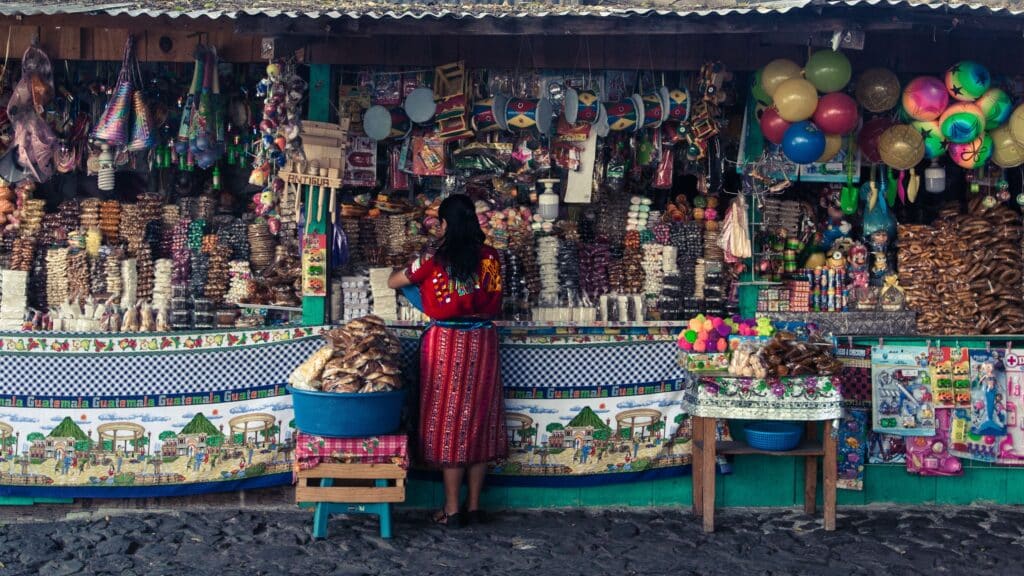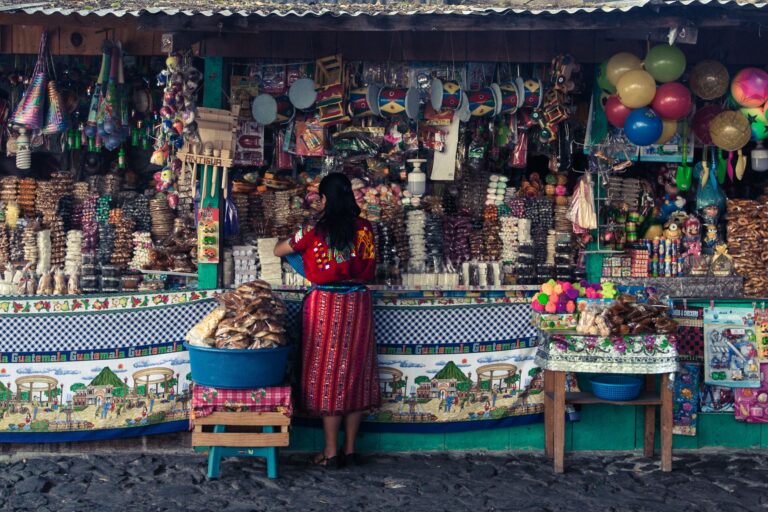Christmas in Guatemala is a time for family, festivities, and unique traditions that blend Mayan sensibilities with Catholic heritage. From Guatemala City to the jungles of the Peten or the highlands of Quetzaltenango, la Navidad is celebrated wholeheartedly by the people of this Central American nation.
Whether you’re moving to Guatemala, plan to visit Guatemala during the holidays, have immigrated away and are missing home, or just want to know more, we have you covered in this guide created by our team here at Remitly.
When is Christmas in Guatemala?
In Guatemala, the Christmas season begins at the beginning of December and continues through the new year into the first week of January. Christmas Day is on December 25, just as in other parts of the world.
The afternoon of Christmas Eve and all of Christmas Day are public holidays in Guatemala, so businesses and schools typically close. The afternoon of New Year’s Eve and all of New Year’s Day are also usually days off from work.
Popular Guatemalan Christmas traditions
As in many other countries in Latin America, Christmas in Guatemala draws inspiration from religious traditions, indigenous customs, and a Spanish tradition or two. Here are some ways that Guatemalans celebrate Christmas and the rest of the holiday season.
La Quema del Diablo and Feast of the Immaculate Conception
December 7 is La Quema del Diablo, or The Burning of the Devil. At 6 p.m., Guatemalans go outside their homes and burn an effigy of the devil.
This unique Guatemalan Christmas tradition dates back to when the country was a Spanish colony. Back then, people often lit lanterns on December 7 to chase away evil spirits. Eventually, bonfires replaced the lanterns, and the holiday was born.
On December 8, Guatemalans celebrate the Feast of the Immaculate Conception in remembrance of when an angel visited the Virgin Mary and told her she would give birth to a son. In Catholicism, the Virgin Mary is a prominent figure due to her holiness, making this feast day a significant celebration.
After the burning of the effigy on December 7, a statue of the Virgin Mary is brought through villages on a wooden float. People follow it all the way to the church and then attend a midnight mass in honor of the Virgin Mary.
Feast of the Virgin of Guadalupe
On December 12, Guatemalans celebrate the Feast of the Virgin of Guadalupe, an important celebration in many Latin American countries. It remembers when a vision of the Virgin Mary visited a Mexican peasant named Juan Diego.
The feast day brings major celebrations throughout Guatemala. Young boys and girls dress in traditional costumes and form a processional that travels through the streets. While they walk, they wave sparklers to the delight of crowds that gather.
Street vendors sell delicious foods, and everyone celebrates. Once the processional reaches the church, everyone files in to attend mass.

Las Posadas
From December 16 to December 24, Guatemalans celebrate Las Posadas, a sort of advent. Each night, a different home displays a wooden float depicting Mary and Joseph. Neighbors come to the home to pray, socialize, and enjoy delicious food and drink.
Decorating for Guatemalan Christmas: Nativity Scenes
Snow is rare in Guatemala, but Guatemalans still enjoy decorating like winter. In fact, you’ll frequently find faux snow on the branches of trees displayed in stores.
As previously mentioned, decorated trees are rare in Guatemala. Instead, you’ll find that most homes put their time and energy into creating “nacimientos,” or nativity scenes.
Nacimientos feature the traditional nativity scene with Mary, Joseph, and baby Jesus, as well as shepherds, angels, and wise men, all figures that are carefully stored each year. Families take great pride in creating elaborate nativity scenes for visitors to enjoy.
These Christmas decorations are usually massive, with the smallest about the size of a four-person dining table. Some can take up an entire garage, complete with rolling hills and fountains trickling water.
There is a tradition in some areas of Guatemala where a visitor will attempt to steal the infant Jesus. If they manage to leave the house with the figure, the family must hold a party to ransom the figure back. It’s all done for fun, of course.
Noche Buena: A Fiery Christmas Eve
Guatemalans celebrate Christmas at midnight on December 24th. Leading up to this hour, they may clean their homes, entertain guests, or attend Mass at their local church. By midnight, nearly everyone is home and ready to celebrate.
At the stroke of midnight, people begin to set off their fireworks, “bombas,” and firecrackers to ring in the holiday. Intense noise and smoke fill the streets in every Guatemalan town for at least 10 minutes, if not longer.
Once the hubbub has quieted down, everyone gives Christmas hugs and kisses to their friends and families and wishes them a “Feliz Navidad.”
People in small towns frequently drift between houses until around dawn, sitting for a tamale and chatting at each place. It’s very much a social affair and a good time to check in on your family and friends.
Savoring Delicious Food
Certain Guatemalan foods are considered essential at Christmas. The Christmas meal nearly always includes Guatemalan tamales. Unlike Mexican tamales steamed in corn husks, Guatemalan tamales or tamales colorados feature stuffed corn dough wrapped in banana leaves before steaming, giving them one-of-a-kind flavor.
Although you’ll usually see tamales colorados on the dinner table, they’re not the only foods associated with a classic Guatemalan Christmas celebration. Some other foods and drinks commonly enjoyed with a traditional Christmas dinner in Guatemala include:
- Whole roast turkey, which the entire family often helps stuff and prepare
- Ponche de frutas, a hot fruit punch featuring dried fruit and cinnamon
- Hot cocoa, often topped with cardamom and cinnamon
- Rompope, a beverage made of eggs, sweetened milk, and rum
Exchanging Presents
On Noche Buena, even though it’s midnight, children are usually still awake and excited about their gifts. This is when families exchange presents — usually only for the little ones in the family. The gifts are not extravagant, perhaps a doll or a toy car and a set of new clothes to wear the next day.
Relaxing on Christmas Day
Since Noche Buena celebrations continue into the early hours of Christmas morning, Guatemalans often sleep in on Christmas Day. Once they wake up, they relax and enjoy leftover food, hot chocolate, and warm fruit punch. For the remainder of the day, people relax and enjoy gazing at the pine needles and other decorations in their houses.
New Year’s Eve
Christmas in Guatemala continues after the 25th. The fun continues into the new year.
Families gather again on New Year’s Eve to eat and drink together. Many people prepare a whole roast pig for the occasion.
The pig is usually dressed with spices, apples, and pineapple and allowed to cook for at least 7 to 8 hours before the meal. Once it’s ready, families carve the pig and enjoy the meat alongside green beans and potato salad.
Three Kings Day
The celebration of Three Kings Day is the last of the Christmas traditions in Guatemala and marks the end of the season. Held on January 6, it honors the trip the three magi took to visit Baby Jesus.
To signal the arrival of the day, churches ring their bells. People often attend mass and return home to relax and clean up their Christmas decorations.
Preparing Rosco de Reyes is a common tradition for the Three Kings Day meal. It’s a loaf of bread shaped into a ring and decorated with cranberries, figs, oranges, pineapple, and other fruits. The shape of the loaf symbolizes the crowns worn by the magi.
Just like on Christmas Eve, Guatemalans may exchange small gifts on Three Kings Day in memory of the presents that the wise men delivered to Baby Jesus.
How Do You Say Merry Christmas in Guatemala?
The official language of Guatemala is Spanish, so Guatemalans greet each other by saying “Feliz Navidad!” throughout the holiday season.
Do They Have Santa Claus in Guatemala?
Getting new toys and other small gifts is part of the fun of the holiday season for Guatemalan children. However, Santa Claus isn’t widely known in the country. You may occasionally see people dressed as the traditional figure in shopping malls and Guatemala City, but elsewhere, you’re unlikely to encounter St. Nick.
Do They Have Christmas Trees in Guatemala?
Christmas trees aren’t traditional in Guatemala despite the pine forests in the mountain highlands. Instead, many families decorate with pine needles, Spanish moss, tinsel, and life-sized sculptures of lambs.
That doesn’t mean there aren’t any decorated trees in the country. It’s not uncommon for a large shopping mall or store to erect a Christmas tree decked out in lights and other decorations during the holidays.
Sending Money Home for Christmas
Christmas is a time when many families put together what they can to celebrate.
Often, family members in other countries, such as Canada and the U.S., will send money to help make Christmas easier to celebrate. No matter the circumstances, it doesn’t take much to enjoy a beautiful time of year with your family.
Frequently Asked Questions (FAQs)
What is Guatemala’s traditional Christmas food?
The Christmas meal nearly always includes Guatemalan tamales, which feature stuffed corn dough wrapped in banana leaves. Some other foods and drinks commonly enjoyed with a traditional Christmas dinner in Guatemala include whole roast turkey, ponche de frutas, a hot fruit punch featuring dried fruit and cinnamon, hot cocoa, often topped with cardamom and cinnamon, and rompope, a beverage made of eggs, sweetened milk, and rum.
Is Christmas a good time to visit Guatemala?
Christmas is a good time to visit Guatemala if you enjoy warm weather. December is the end of the rainy season, with temperatures between 70-82°F. However, it’s also the busiest season with the most tourists, so book a trip well ahead. There’s also a festive atmosphere around Christmastime – cities and towns are decorated with lights and ornaments.
Do they have Christmas trees in Guatemala?
Christmas trees aren’t traditional in Guatemala despite the pine forests in the mountain highlands. Instead, many families decorate with pine needles, Spanish moss, tinsel, and life-sized sculptures of lambs. However, shopping malls have Christmas trees decked out in lights and other decorations.
What is the Guatemalan equivalent name for Santa Claus?
In Guatemala, the equivalent name for Santa Claus is “El Niño Dios,“ which translates to “The Christ Child.” The traditional Santa Claus isn’t widely known in the country. You may occasionally see people dressed as Santa Claus in shopping malls and Guatemala City, but elsewhere, you’re unlikely to encounter St. Nick.
What special events take place in Guatemala during the Christmas season?
December 7th is La Quema del Diablo, or The Burning of the Devil. Guatemalans burn an effigy of the devil. Afterwards, a statue of the Virgin Mary is brought through villages on a wooden float. People follow it to the church and then attend a midnight mass.
On December 8th, Christians celebrate the Feast of the Immaculate Conception. On December 12th, the Feast of the Virgin of Guadalupe occurs. Children dress in traditional costumes and form a small procession that travels through the streets.
From December 16th to December 24th, Guatemalans celebrate Las Posadas. Each night, a different home displays a wooden float depicting Mary and Joseph . Most homes put up “nacimientos,” or nativity scenes. Nacimientos feature the traditional nativity scene depicting the birth of Jesus. In some areas of Guatemala, a visitor will attempt to steal the infant Jesus. If they manage to leave the house with the figure, the family must hold a party to ransom the figure back.
Carols also play a central role in the celebration. Known as “villancicos,” these traditional songs are sung in both Spanish and English.

